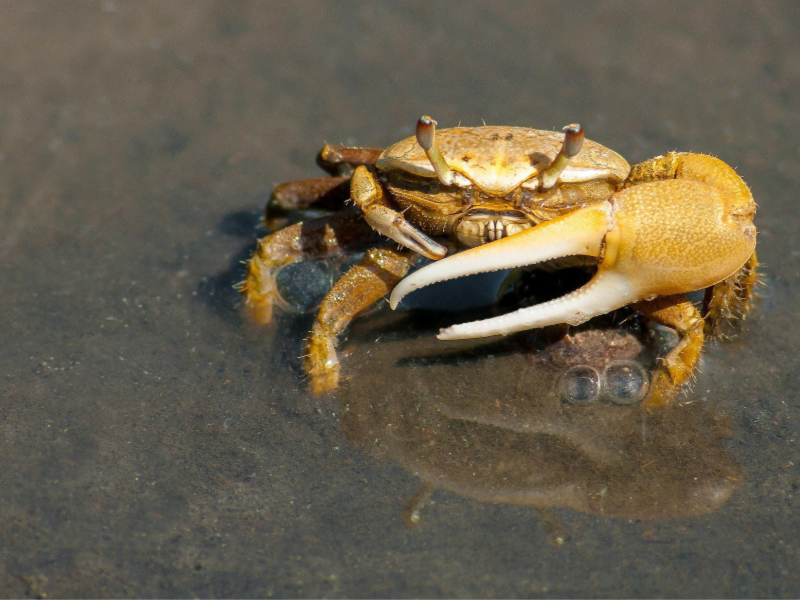Crabbing – /krab/ verb
- The term used to describe an exciting coastal activity with family members
- What family members do when they aren’t having fun. See complaining
Because crabs are far better covered in butter than used as a term for your family members’ boredom, let’s focus on the first definition. Keep on reading to learn all you need to know before you go crabbing in Oregon.
How to Prepare for Crabbing in Oregon
There are three things you should do before any crabbing excursions:
- Have a crab gauge to measure the width of the shell. Whatever crab you catch, you must follow the current regulations to know which crabs are legal to keep.
- You will also want to check Oregon’s crabbing and clamming report before you head out to crab for the day. This will let you know which areas are open or closed to crabbing.
- Check the Shellfish Biotoxin Closures page of Oregon.gov to avoid any possible biotoxin exposure. This includes the waters where the crab may be living so you can avoid contamination once you’ve hauled-in your quarry. Never use the water the crabs are boiled in for soups, stews, or rinsing utensils for other food preparation, regardless of biotoxin levels.
What About a License for Crabbing in Oregon?
You will need a license to not only catch crab but to operate the traps. Each person participating in the activity must have a license, even if that simply means lowering a trap into the water. Lucky for us, licenses are easy to get online through the Oregon Department of Fish & Wildlife starting December 1 of each year. Licenses are valid until the following December.
Catching Your Crabs
There are two primary crab traps: rings and pots. The main difference being that crabs cannot escape as easily from pots as they can rings. A ring lays flat on the bottom of the bay until you lift on the rope causing it to shape into a basket. Therefore, they need to be checked more frequently to avoid giving the critters a free meal—a true seafood dine-and-dash caper. Rings also need to be pulled up quickly to get more crabs. Pots retain the crabs longer but still need to be checked regularly. How long exactly is a hot debate among Oregon crabbers.
Whether you use rings or pots, consider chicken as bait instead of fish to attract crabs instead of hungry sea lions that can destroy your traps. You can secure the bait directly to the ring or pot, or buy a bait cage to wire onto your trap. Some old-time crabbers like to punch holes in a can of cat or dog food and wire those into the trap too, making for a stinky, crab-attracting smorgasbord. Keep in mind when using rings or pots, hold on to something before you throw them out or you are liable to make a splash of your own!
Can you lasso a crab?
Yes, you can. A fishing pole with a crab snare (essentially a bait box with filament loops) makes you an agile crab catcher who is also frugal. You can even make one yourself fairly easily. “Crab-hawk” type snares are also effective if you desire to use your fishing pole. Think of all the places you can go with a snare or crab-hawk. Every beach, dock, pier, boat, bridge becomes a potential crabapalooza!
Can you grab a crab, or will it grab you?
Be sure to have gloves with you if you’re new to the sport. Approach by picking up the crab away from their claws—index finger under the crab, thumb on its back–and expect them to resist. If you get pinched, wait a bit and they will usually let go. The key is to not panic.
I Caught One! But What Kind Is It?
If it has white-tipped claws and a deep red or even purplish color, it is Dungeness, considered one of the world’s great delicacies. They are the treasure of the Oregon coast for their sweet flavor. You can only keep up to 12 males and they must be 5 and ¾ inches in width, so have a crab gauge with you. Males have a narrower triangle on the underside of their shells. If the creatures you catch have black-tipped claws with a brick-red color, then you have got yourself some Red Rock crabs. Aptly named, you’ll likely find them hiding near rocks. You can currently keep up to 24 of the Red Rock crabs of any size or sex.
In Season
Crab season opens in the Spring (March, April, or May) but the surf and tides are what make the difference as to when the crabs arrive. Any time of year, crabs can be found, and the winter is often the best time for catching crab at the Oregon coast. In the winter, most of the Dungeness will have hard shells and be packed full of meat. When crabbing in Oregon, both of these delicious creatures are plentiful and ready to catch.
Tides
Right at the slack tides, especially the incoming ones, are your best times for maximum crab catching. High-water movement makes it hard for the crabs to get around to find your bait. Pick times when the water is moving the least. Check out an Oregon tide table before you go to choose the optimal time to hit the water.
Crabbing in Oregon for the Weekend
While you’re crabbing in Oregon, stay with us! We have our lowest rates during peak crabbing season. Kick back after a fun day on the water on our sparkling clean sheets and comfortable beds. Old Town Inn will be just the place to sleep soundly with a belly full of crab and a smile on your face. Book directly through our website or front desk (call 888-824-2454) to save money and get the best, most accurate availability of rooms.

